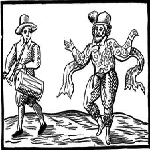Annotation:Kemp's Jig

KEMP'S JIG. AKA and see "Roland." English, Country Dance Tune. D Major (Johnson, Raven): D Minor (Playford). Standard tuning (fiddle). One part (Raven): AB (Johnson): AAB (Playford). Published by Playford in his English Dancing Master (1651). The tune dates to the 16th century and commemorates the feat of Will Kemp, a member and shareholder with William Shakespeare in the Company of the Lord Chamberlain's Men and the Globe Theatre, who bet he could dance a morris jig from London to Norwich (about 125 miles). Kemp was a famous comic actor and clown, and it is likely that Shakespeare wrote some of his early characters with Kemp in mind. He played the part of Dogberry in Much Ado About Nothing, and is famous for creating the Auguste character (thought to have been descended from the Vice character of medieval mystery plays), although Shakespeare and he may have had a falling out due to his penchant for improvising and playing to the crowd.
Kemp's dancing feat took approximately nine days, spread out over about a month in order that he might rest and recuperate during the journey. He was accompanied by a pipe-and-tabor musician and a referee who kept strict watch that he danced the distance; important as betting was heavy and Kemp put up a considerable sum on himself to complete the distance. His feat, really a publicity stunt of sorts, proved lucrative for in addition to his winnings he received a pension from Norwich and published a book on his exploit entitled Kemps Nine Daies Wonder: Performed in a Daunce from London to Norwich: Containing the Pleasure, Paines and Kinde Entertainment of William Kept between London and that Citty in his Late Morrice: Wherein is Somewhat Set Downe Worth Note; to Reproove the Slaunders Spred of Him: Many Things Merry, Nothing Hurtfull. It was first published in London in 1600. Kemp died in 1603.
Researcher Anne Gilchrist noted: "Kemp's Jigge" is the heading of some music collected by [English composer] John Dowland in the Library of Cambridge University, Ms. Dd ii, 11.--E.K.W."[1]. "Strictly," notes Keith Whitlock[2], "jigs were short 'revue' pieces with songs and dancing, that followed a play performance. They were commonly bawdy and satirical:
Whores, Bedles, bawdes and Sergeants filthily
Chaunt Kemp's Jigge..."
If a song was sung to the tune, it does not survive. John M. Ward posits that "Kemp's Jig" was a musical branch of "Staines Morris," though it had a relatively short life, with "no version having been found after the Playford divisions for violin included in several editions of Introduction to the Skill of Muscik, including the last one, in 1730"[3].
- ↑ Anne G. Gilchrist, "Some Additional Notes on the Traditional History of Certain Ballad-Tunes in the Dancing Master", Journal of the English Folk Dance and Song Society, vol. 3, No. 4, Dec., 1939, p. 275).
- ↑ Keith Whitlock, “John Playford’s English Dancing Master 1650/51 as Cultural Politics”, Folk Music Journal, vol. 7, No. 5, 1999, p. 563
- ↑ John M. Ward, "The Morris Tune", Journal of the American Musicological Society, vol. 39, No. 2, Summer 1986, p. 310

